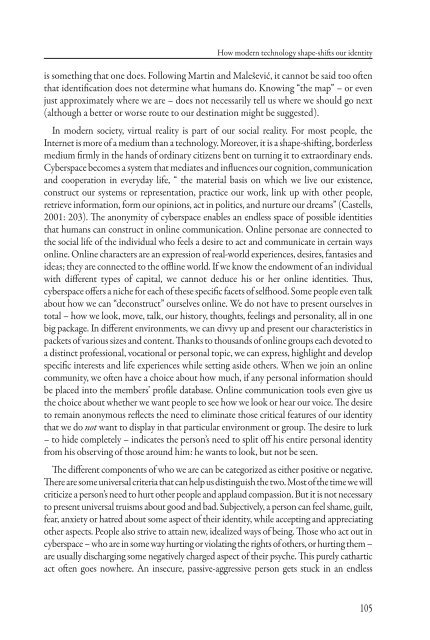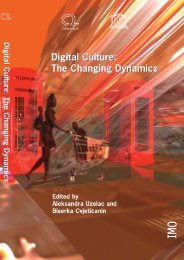free download in pdf format - Culturelink Network
free download in pdf format - Culturelink Network
free download in pdf format - Culturelink Network
You also want an ePaper? Increase the reach of your titles
YUMPU automatically turns print PDFs into web optimized ePapers that Google loves.
How modern technology shape-shift s our identity<br />
is someth<strong>in</strong>g that one does. Follow<strong>in</strong>g Mart<strong>in</strong> and Malešević, it cannot be said too oft en<br />
that identifi cation does not determ<strong>in</strong>e what humans do. Know<strong>in</strong>g “the map” – or even<br />
just approximately where we are – does not necessarily tell us where we should go next<br />
(although a better or worse route to our dest<strong>in</strong>ation might be suggested).<br />
In modern society, virtual reality is part of our social reality. For most people, the<br />
Internet is more of a medium than a technology. Moreover, it is a shape-shift <strong>in</strong>g, borderless<br />
medium fi rmly <strong>in</strong> the hands of ord<strong>in</strong>ary citizens bent on turn<strong>in</strong>g it to extraord<strong>in</strong>ary ends.<br />
Cyberspace becomes a system that mediates and <strong>in</strong>fl uences our cognition, communication<br />
and cooperation <strong>in</strong> everyday life, “ the material basis on which we live our existence,<br />
construct our systems or representation, practice our work, l<strong>in</strong>k up with other people,<br />
retrieve <strong>in</strong><strong>format</strong>ion, form our op<strong>in</strong>ions, act <strong>in</strong> politics, and nurture our dreams” (Castells,<br />
2001: 203). Th e anonymity of cyberspace enables an endless space of possible identities<br />
that humans can construct <strong>in</strong> onl<strong>in</strong>e communication. Onl<strong>in</strong>e personae are connected to<br />
the social life of the <strong>in</strong>dividual who feels a desire to act and communicate <strong>in</strong> certa<strong>in</strong> ways<br />
onl<strong>in</strong>e. Onl<strong>in</strong>e characters are an expression of real-world experiences, desires, fantasies and<br />
ideas; they are connected to the offl <strong>in</strong>e world. If we know the endowment of an <strong>in</strong>dividual<br />
with diff erent types of capital, we cannot deduce his or her onl<strong>in</strong>e identities. Th us,<br />
cyberspace off ers a niche for each of these specifi c facets of selfh ood. Some people even talk<br />
about how we can “deconstruct” ourselves onl<strong>in</strong>e. We do not have to present ourselves <strong>in</strong><br />
total – how we look, move, talk, our history, thoughts, feel<strong>in</strong>gs and personality, all <strong>in</strong> one<br />
big package. In diff erent environments, we can divvy up and present our characteristics <strong>in</strong><br />
packets of various sizes and content. Th anks to thousands of onl<strong>in</strong>e groups each devoted to<br />
a dist<strong>in</strong>ct professional, vocational or personal topic, we can express, highlight and develop<br />
specifi c <strong>in</strong>terests and life experiences while sett<strong>in</strong>g aside others. When we jo<strong>in</strong> an onl<strong>in</strong>e<br />
community, we oft en have a choice about how much, if any personal <strong>in</strong><strong>format</strong>ion should<br />
be placed <strong>in</strong>to the members’ profi le database. Onl<strong>in</strong>e communication tools even give us<br />
the choice about whether we want people to see how we look or hear our voice. Th e desire<br />
to rema<strong>in</strong> anonymous refl ects the need to elim<strong>in</strong>ate those critical features of our identity<br />
that we do not want to display <strong>in</strong> that particular environment or group. Th e desire to lurk<br />
– to hide completely – <strong>in</strong>dicates the person’s need to split off his entire personal identity<br />
from his observ<strong>in</strong>g of those around him: he wants to look, but not be seen.<br />
Th e diff erent components of who we are can be categorized as either positive or negative.<br />
Th ere are some universal criteria that can help us dist<strong>in</strong>guish the two. Most of the time we will<br />
criticize a person’s need to hurt other people and applaud compassion. But it is not necessary<br />
to present universal truisms about good and bad. Subjectively, a person can feel shame, guilt,<br />
fear, anxiety or hatred about some aspect of their identity, while accept<strong>in</strong>g and appreciat<strong>in</strong>g<br />
other aspects. People also strive to atta<strong>in</strong> new, idealized ways of be<strong>in</strong>g. Th ose who act out <strong>in</strong><br />
cyberspace – who are <strong>in</strong> some way hurt<strong>in</strong>g or violat<strong>in</strong>g the rights of others, or hurt<strong>in</strong>g them –<br />
are usually discharg<strong>in</strong>g some negatively charged aspect of their psyche. Th is purely cathartic<br />
act oft en goes nowhere. An <strong>in</strong>secure, passive-aggressive person gets stuck <strong>in</strong> an endless<br />
105



